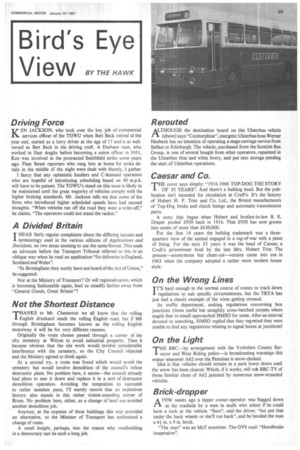B i rd s Eye
Page 61

If you've noticed an error in this article please click here to report it so we can fix it.
VleNIV BY THE HAWK
Driving Force
KEN JACKSON, who took over the key job of commercial services officer of the TGWU when Bert Beck retired at the year end, started as a lorry driver at the age of 17 and is as wellversed as Bert Beck in the driving craft. A Durham man, who worked in East Anglia before becoming a union officer in 1951, Ken was involved in the protracted Smithfield strike some years ago. Fleet Street reporters who rang him at home for strike details in the middle of the night were dealt with bluntly. I gather.
I fancy that any optimistic hauliers and C-licensed operators who are hopeful of introducing scheduling based on 40 m.p.h. will have to be patient. The TGWU's stand on this issue is likely to be maintained until the great majority of vehicles comply with the higher braking standards. Mr. Jackson tells me that some of the firms who introduced higher scheduled speeds have had second thoughts. "When vehicles ran off the road they were a write-off," he claims. "The operators could not stand the racket."
A Divided Britain
T HEAR fairly regular complaints about the differing iayouts and terminology used in the various editions of Applications and Decisions, no two areas seeming to use the same format. This week an advocate before the Transport Tribunal referred to this in an oblique way when he read an application "for deliveries in England, Scotland and Wales".
"In Birmingham they surely have not heard of the Act of Union," he suggested.
Nor at the Ministry of Transport? Or will regionalization, which is becoming fashionable again, lead us steadily farther away from "General Goods, Great Britain"?
Not the Shortest Distance
PrHANKS to Mr. Chesterton we all know that the rolling -L English drunkard made the rolling English road, but if M6 through Birmingham becomes known as the rolling English motorway it will be for very different reasons.
Originally the route chosen passed through a corner of the city cemetery at Witton to avoid industrial property. Then it became obvious that the site work would involve considerable interference with the cemetery, so the City Council objected and the Ministry agreed to think again.
At a second try, a route was found which would avoid the cemetery but would involve demolition of the council's refuse destructor plant. No problem here, it seems—the council already had plans to tear it down and replace it in a sort of destructor demolition operation. Avoiding the temptation to succumb to rather tasteless puns, Ill merely record that an explosives factory also stands in this rather violent-sounding corner of Brum. No problem here, either, as a change of land use avoided another demolition job.
Anyway, at the expense of three buildings this way provided an alternative, so the Minister of Transport has authorized a change of route.
A small insight, perhaps, into the reason why roadbuilding in a democracy can be such a long job.
Rerouted
A,THOUGH the destination board on this Ulsterbus vehicle (above) says "Corstorphine", energetic Ulsterbus boss Werner Heubeck has no intention of operating a stage carriage service from Belfast to Edinburgh. The vehicle, purchased from the Scottish Bus Group, is one of several bought from other operators, repainted in the Ulsterbus blue and white livery, and put into storage pending the start of Ulsterbus operations.
Caesar and Co.
rr HE cover says simply: "1916-1966 TOP-DOG THE STORY OF 50 YEARS". And there's a bulldog head. But the publication isn't intended for circulation at Cruft's. It's the history of Hubert H. P. Trist and Co. Ltd., the Bristol manufacturers of Top-Dog brake and clutch linings and automatic transmission parts.
A story that began when Hubert and brother-in-law B. E. Draper pooled £950 back in 1916. That £950 has now grown into assets of more than £630,000.
For the first 14 years the bulldog trademark was a threequarters view of the animal engaged in a tug-of-war with a piece of lining. For the next 33 years it was the head of Caesar, a Cruft's prizewinner bred by the late Mrs. Hubert Trist. The present—anonymous but clean-cut—version came into use in 1963 when the company adopted a rather more modern house style.
On the Wrong Lines
IT'S hard enough in the normal course of events to track down regulations to suit specific circumstances, but the TRTA has just had a classic example of the wires getting crossed.
Its traffic department, seeking regulations concerning box junctions (those useful but unsightly cross-hatched carpets where angels fear to tread) approached HMSO for same. After an interval devoted to searching, HMSO replied that they regretted they were unable to find any regulations relating to signal boxes at junctions!
On the Light
THE BBC—by arrangement with the Yorkshire County Surveyor and West Riding police—is broadcasting warnings this winter whenever A62 over the Pennines is snow-choked.
Idea is that vehicles should remain in a park lower down until the snow has been cleared. Which, if it works, will rob BBC-TV of those familiar shots of A62 jammed by numerous snow-stranded vehicles.
Brick-dropper
AFEW weeks ago a tipper owner-operator was flagged down at the roadside by a man in mufti who asked if he could have a look at the vehicle. "Sure", said the driver, "but put that under the back wheels or she'll run back", and he handed the man a 41 in. x9 in. brick.
"The man" was an MoT examiner. The GV9 read: "Handbrake inoperative".




























































































































